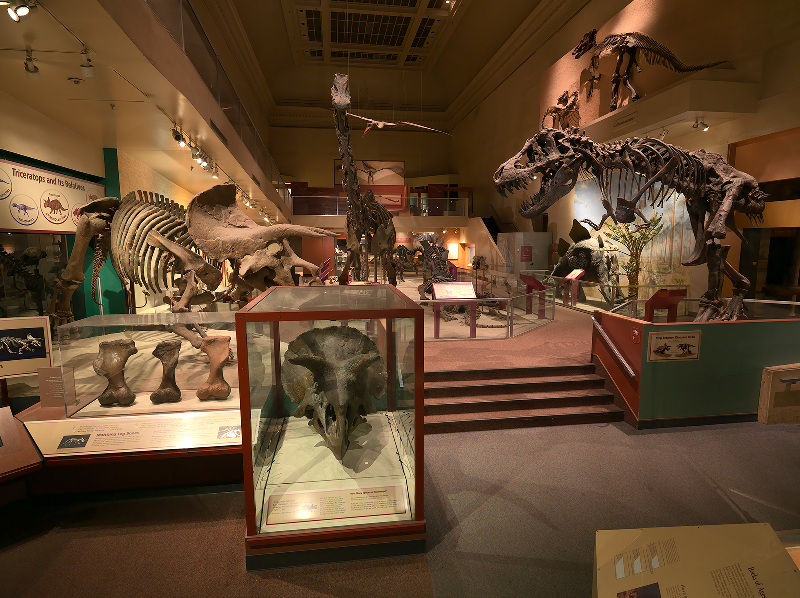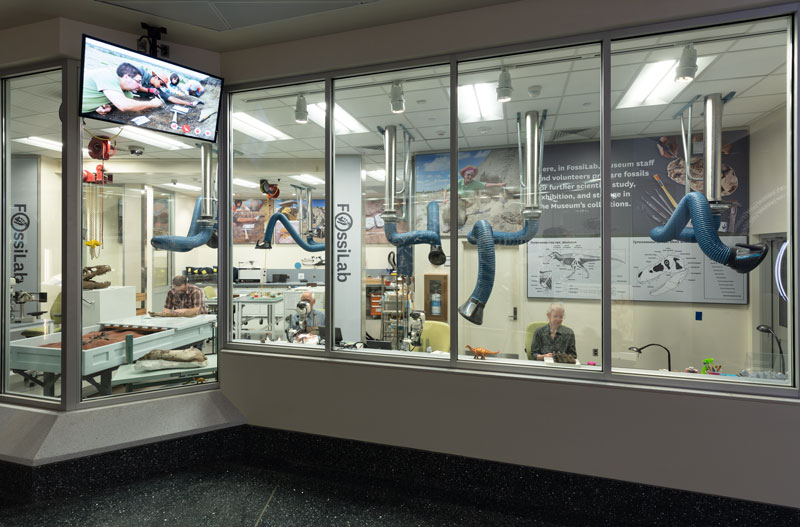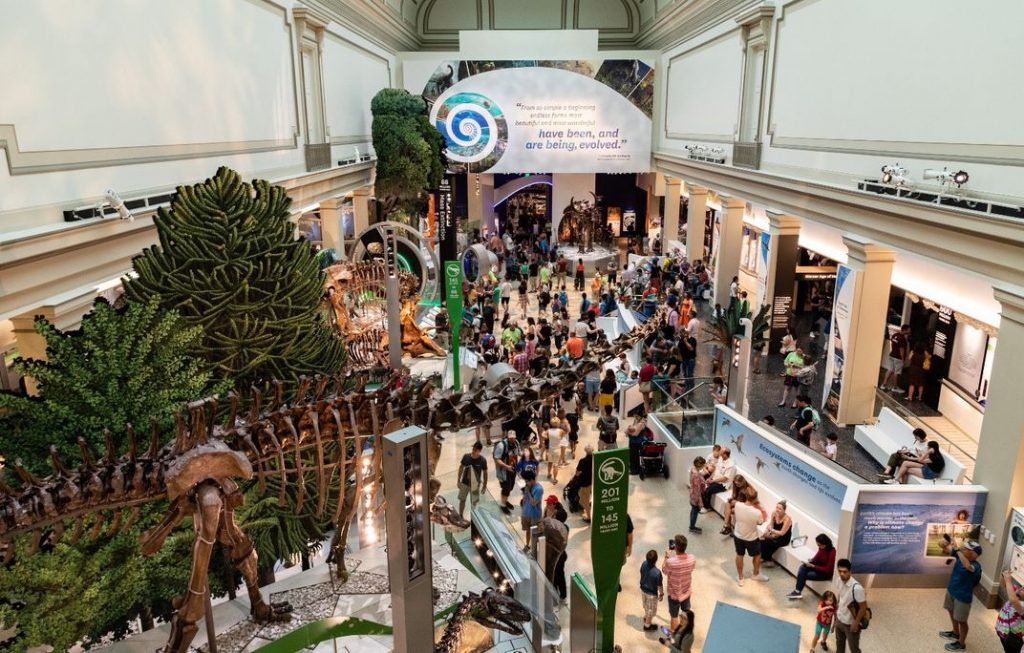After five years and millions of dollars of renovation, the Smithsonian Institution’s National Museum of Natural History has finally opened the doors of their new fossil hall: Deep Time. And at last, we got to pay them a visit!
Our Cricket Media DC office is just a short metro ride away from the National Mall, and we’ve been fortunate to collaborate with the Smithsonian on everything from articles to an annual invention contest. What’s more, this month’s issue of CLICK Magazine is all about the wonders of collections of all shapes and sizes. The story “Dana Darling, Dino Detective” follows a scientist who assembles dinosaur fossil displays in a museum. This story is a great way to prep younger children for a visit to Deep Time. Most kids—and many adults—don’t realize how much work goes into preparing a fossil for an exhibit, requiring power tools, plaster casts, metal frames, and more. Inspired by Dana Darling’s daring displays, we plunged into Deep Time.


The old Fossil hall (Smithsonian Institution) 
The renovated Fossil hall (Lucia Martino, Smithsonian Institution)
Your Childhood Is Calling
A bright green banner hangs above the steps of the Natural History Museum, reading, “Your Childhood is calling. It sounds a bit like ‘RAAWWR’.’” Most adults who spent their childhoods in the Washington DC area can share fond memories of going downtown to see the dinosaurs. In fact, the old fossil hall received over eight million visitors a year. It’s mind-boggling that there are five-year-old children in the District who’ve spent their whole lives without saying hi to a Hadrosaurus. So needless to say, fans have been following the progress of the new exhibit with rapt attention. Fortunately, if the visitors’ reactions and our own trip can be taken as evidence, it’s a hit.
The new exhibit is worlds—or eons—away from the musty, dimly lit old fossil hall. After ditching stifling walls that subdivided the display space and a second floor that seemed to box in the tallest fossils, the new exhibit hall is bright, airy, and open. Rather than a stifling maze prone traffic jams caused by strollers and school field trips, the winding paths never became too congested, even though we visited on a holiday weekend. There’s so much to see and do that even the most popular exhibits didn’t stop the flow of guests. And this time, there’s a new story.


A Journey Back In Time
When you step into Deep Time, the first animal you see isn’t a dinosaur. It’s a human: a bronze sculpture of a prehistoric woman carrying a baby, followed by a wary hunter. This new exhibit is designed as a journey back in time, from modern day to the Ice Age to the age of the dinosaurs to the earlier eras that we often overlooked. It’s the history of life on earth– and how life shapes the evolution and ecosystems on earth.
Two big walls cut across the exhibit to represent the biggest mass extinctions ever to occur: the famous extinction at the end of the Cretaceous period (the one responsible for the end of dinosaurs), and the lesser-known but even more massive Permian extinction 252 millions of years ago. According to a display in the exhibit, over 90% of ocean creatures went extinct. Signs tell us that, even if it takes millions of years, the earth can recover and adapt following a mass extinction. We don’t need to worry about the end of the world—just the end of humans. We’re not sure if that’s supposed to be comforting or terrifying!

The centerpiece of Deep Time is not a dinosaur but the huge skeleton of a mastodon, which stands in cool contrast to the friendly taxidermized African elephant in the museum’s rotunda just outside the exhibit. The two closely-related species aren’t so different, after all. One is extinct, and another is increasingly threatened.
There’s an unbelievably gigantic ground sloth, the mummified remains of an Ice Age bison, and the prehistoric ancestors of some of the animals we love today, like horses and dogs. You’ll also find the oldest mounted fossil display in the museum here: an Irish elk that has been displayed at the museum since 1872! (The name ‘Irish elk’ does not do its coolness justice. Look for the creature with the impossibly wide antlers and imagine how it navigated the earth without getting stuck on things.)
Then, it’s on to the dinosaurs!


Celebrity Specimens
Ask a kid to name a dinosaur and you’re likely to hear “T-Rex!” Way before Deep Time’s opening date, the news of the ‘Nation’s T-Rex’ made a big splash. Until now, the Smithsonian had never displayed a real Tyrannosaurus fossil before, but now it’s home to one of the largest and most complete specimens ever found. The T-Rex is the star of the show at Deep Time. In the new exhibit, he can be found dramatically devouring a Triceratops. (Is he killing the poor guy or just scavenging prehistoric roadkill? Leading scientists disagree on the king of dinosaurs’ eating habits; the museum politely leaves it open to interpretation.) But the nation’s T-Rex and his unfortunate lunch aren’t the only celebrity specimens in the museum.


There’s a long-necked Diplodocus looming over the exhibit (you can touch its huge humerus bone and measure your height against it)! There’s the first nearly complete Allosaurus fossil ever found. It’s one of the most studied dinos in the whole world! And found at the same location, a stegosaurus that’s used as a ‘type.’ That means it was the first Stegosaurus ever discovered, and scientists use it to identify other Stegosaurus fossils. The Stegosaurus on display doesn’t look like much— it’s all in pieces– but it’s one of the most important fossils in the museum! Can you spot the small plant-eating dinosaur that still has fossilized tendons and cartilage as well as bones?
Don’t miss some of the weird and wonderful creatures that existed before the days of the dinosaurs! Some of them look more like children’s drawings than real creatures.


Interactive Excitement
In the museum’s earliest days, fossils were simply lined up in glass cases and drawers with dry, scholarly labels. Nowadays, museums aren’t just for researchers. They’re an exciting outing for the general public, including kids! You’ll find tons of interactive features lining the exhibit. Guests can watch thirteen videos, play with eight touchscreens, and even touch real fossils over 150 million years old! Press a button to see the funky stride of an early tetrapod, climb on a sculpture of Charles Darwin, play a game of chance to determine whether you’d become a fossil, and zoom a digital magnifying glass over ancient insects.
On our visit, small kids seemed to get a kick out of the delicate little dioramas illustrating prehistoric scenes. One little boy actually began crying when his mother tried to lead him away from one featuring a primordial swamp. These little worlds are decorated with toy creatures not so different from those your children might own. It’s an example of how the biggest and flashiest displays may not be the most attractive to children.

What’s the coolest interactive feature of all? Peering into the FossiLab! This is a real laboratory where scientists work on cleaning fossils, creating plaster casts, and assembling displays. Kids will love getting to see them work in real time. Index cards explain the tasks that the scientists and volunteers are doing at the moment. On our visit, a scientist painstakingly worked at removing a gorgosaurus fossil from plaster. We couldn’t help but wonder whether the researchers felt funny being on display in a glass case just like the fossils!


Pay a Visit!
Scott L. Wing, a research geologist and paleobiologist at the Smithsonian, writes:
“The theme of the new exhibit concerns the future as well as the past…. Every visitor who comes to the new fossil hall has inherited a 3.7 billion-year-old legacy– the living system they depend on. The new hall puts our time in the context of deep time, helping people see that their actions today leave a legacy that ripples thousands of generations into the future. “
After leaving the exhibit, you might want to hear what insights your kids have about the future of our world. What do they think the planet will be like in millions of years? What kind of creatures will live there? And what do they think people should do to help care for the earth? Sharing thoughts on this matter might– just might– be engrossing enough to avoid the dino-themed toys and gifts for sale just outside the exhibit!
The National Museum of Natural History, like all Smithsonian museums, is completely FREE! It’s open every day except Christmas from 10-5:30 PM and can be found right on the National Mall. Have you visited Deep Time? Share your experience with us!



